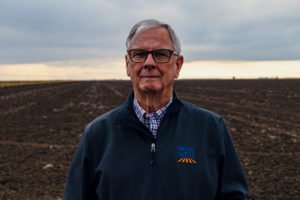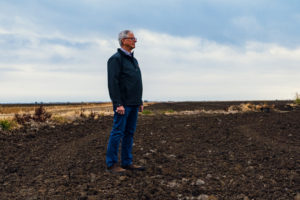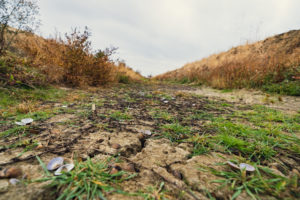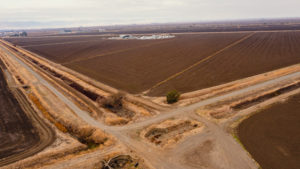Growing Together Winter 2023
Industry Engagement is Vital During Unsteady Times: Massive farm-level change clarifies need to engage next generation of growers
Don Bransford thought he had seen it all.
A third-generation farmer in Colusa, California, Bransford and his wife and business partner Diane oversee an operation that includes about 1,800 acres of rice and 200 acres of almonds in the Sacramento Valley, a region that supplies the U.S. with most of its sushi rice.

Normally a hub of activity as well as a symphony of wildlife noises for most of their 42 years running the farm, no amount of planning could have prepared the couple for 2022.
“The troubling aspect of this is it’s not a fire. It’s not a flood,” Bransford said. “Visually, most people don’t see anything, but my fields are tilled. So there are 1,800 acres of bare dirt.”
It’s just one of the reasons the rice grower and longtime Grow West customer has prioritized industry engagement and leadership locally all the way to the federal level. Though there’s much that’s out of his control — like the multiyear drought that led to some tough decisions in the last year — there’s a lot that he is willing and able to do.
Speaking on behalf of his industry and fellow farmers takes him out of the fields he loves so much. He has long seen his engagement in regulation and policymaking as vital to the industry’s future whether in times of general prosperity or — more as is the case in late 2022— when challenges sometimes seem insurmountable.
From higher education to rice fields
The 1980s was a tsunami of bad news for many in agriculture. Interest rates rose to a high of 21.5% in 1981. In response to the Soviet Union’s invasion of Afghanistan, President Jimmy Carter halted grain shipments to the USSR. After record production, there was a glut of farm commodities, and prices sank. Land values plummeted as much as 60% in some parts of the country. In 1984, farm debt hit $215 billion. Farm foreclosures soared.
It was in this economic climate that Don Bransford left the life of a college professor for the uncertainty of farming.
“The interesting thing is my first rice crop was planted in 1980. And we had record prices for the rice crop and I thought ‘Wow, this is a pretty good deal,’” said Bransford.
Reality reared its ugly head in year two.
“All hell broke loose and we went from three lucrative markets to zero markets,” Bransford said. “The rice price was $14.00 and went to $7.00 and the ground that was selling for $4,200 based on that pricing went to $2,000.”
Cyclical moves like that are what contribute to agriculture being a profession not suited for the faint of heart. But Don and Diane — eternal optimists — never questioned their choice or looked back.
“Life is a journey. There’s always some good that comes from each of your experiences,” said Don. “They may not all be good, but we’ve been very happy with the choice we made.”
A lifetime of engagement
In the corporate arena, it may be viewed as a return on investment. On the farm, one may be tempted to call it “giving back.” But in an agriculture community of approximately 4,000, Don has taken it to the next level.
His service to agriculture and his community is wide-ranging; he currently serves on the Board of the Glenn-Colusa Irrigation District and is the past Chairman of the California Rice Commission, the California Rice Producers’ Group and the Northern California Water Association. He was also appointed to the State Board of Food and Agriculture, the Bay Delta Advisory Council of CALFED and to the State of California, Governor’s Advisory Drought Planning Panel. In addition, he’s testified before the U.S. Congress on Farm Bill matters. Don’s engagement stretches beyond agriculture, too, as he also served on the Colusa Unified School Board for 33 years.
Why devote so much time and energy to such a range of organizations touching on both his community and agriculture? Don sees part of it as a function of age.
“Engagement is important. I’m a little older. I worry that the younger farmers; they obviously are trying to build businesses but I’m not sure they all see the importance of this engagement. If they want long-term success, they’ve got to figure out how to engage. Maybe it’s the old guy’s responsibility to figure out a way to help them engage,” Bransford said. “That’s my concern for agriculture because hired experts are fine, but at the end of the day you’ve got to have farmers in the room to intelligently talk to legislators and regulators. I just think that makes a big difference.”
A tireless advocate for California agriculture, Bransford believes that for many consumers, there is a disconnect concerning the origination of their food.

“For many people, food comes from a grocery store. We need to help them understand we’re not using all the water, polluting the environment. It’s becoming more and more important to educate the public that it takes water to grow food. We produce the safest food in the world, and we don’t want a country of imported food.”
Grow West plays an important role in engagement on multiple levels to help the impact of California agriculture, according to Bransford. This includes sponsorship of the California Farm Water Coalition, a non-profit organization that works to help consumers, elected representatives, government officials and the media make the connection between farm water and the food supply.
Water is increasingly the target of state and federal regulation that limits availability for growers like Bransford, with both short- and long-term implications. Drastically shortened water availability for agriculture has real implications for Grow West and its grower customers in the short term. But in the long term, those ramifications of things like year-over-year moisture shortfalls broaden the influence of uninformed policy targeting agriculture.
“I think with the recession and the price of food, people are waking up and seeing supermarkets are not as stocked as they used to be. It’s all about drought and not being able to produce the commodities that we do,” he said. “The impact on fresh produce, that’s going to really take a hit.”
An Uncertain Future
Legendary underwater explorer Jacques Cousteau once said, “we forget that the water cycle and the life cycle are one.” It’s a sentiment not lost on any farmer.
“We’ve had two years of precipitation in the last three years, so we’re one full year behind and that’s caused a huge dent in the supply coupled with the warming climate.”
In a normal dry year, under the terms of a deal with state and federal water agencies, Bransford would receive a 75% supply of water from the Sacramento River. This year, he could only be guaranteed 18%. Without a reliable supply of water, he had no choice. For the first time in over 40 years, Don Bransford made the difficult decision to forgo a rice crop and fallow his fields.

A report from the University of California Merced found that the 2021 drought cost over 14,300 jobs in the state, with economic losses totaling $1.7 billion. The costs from this year’s drought are expected to be 50% higher.
Bransford describes the outlook as “dire.”
“In some respects, this is like the market crashing. You’re rolling along and you’re doing fine and then the next day the market crashes. Then all of a sudden, you may be overextended,” he said. “You say ‘Well, you know, I’m not going to do that again.’ And I think most of us are probably going to weigh more heavily on where our investments are in terms of ‘Do I need that new piece of equipment? Or should I buy a used piece of equipment instead?’”
Unsettling quiet
In previous years, the Bransford farm provided habitat for a stunning array of wildlife. The flooded fields and the waste grain were critical for the winter survival of migrating birds.
In a normal year, there can be upwards of 230 species of wildlife — birds, mammals, amphibians and reptiles — inhabiting Bransford’s rice fields. The Sandhill Cranes usually stop in the fields in September.

Not this year.
“There is nothing. I have roosting poles out on my land for hawks. No hawks. I’ve not seen a coyote. I’ve not seen a fox. I’ve not seen a skunk there. There’s nothing, and certainly no snakes. Hopefully, the impacts will not be lasting but only time will tell.”
This silence tells Bransford that beyond the lack of wildlife activity this year, the multiyear drought facing his area will have other effects even when more “normal” conditions return. Water availability and environmental stewardship will continue to be hot-button issues. And it will be up to future agricultural leaders to stay engaged in the regulatory and policymaking processes to meet the challenge head-on in changing what they can and working around what they can’t.
“I think there’s always going to be pressure to use less water and how the water’s distributed. The environmental stewardship this state prides itself in will always create pressure in agriculture,” Bransford said. “My concern on that is agriculture’s engagement, and I don’t think we will make headway unless we engage and do so in a new way. You have to pick and choose your battles, but you have to take the time and know you’re going to have an impact. You just have to stay at it.”
